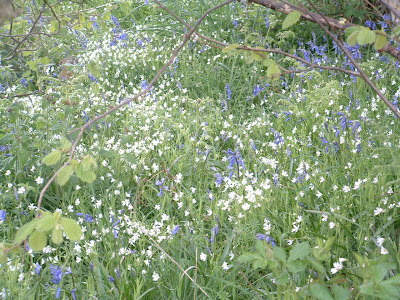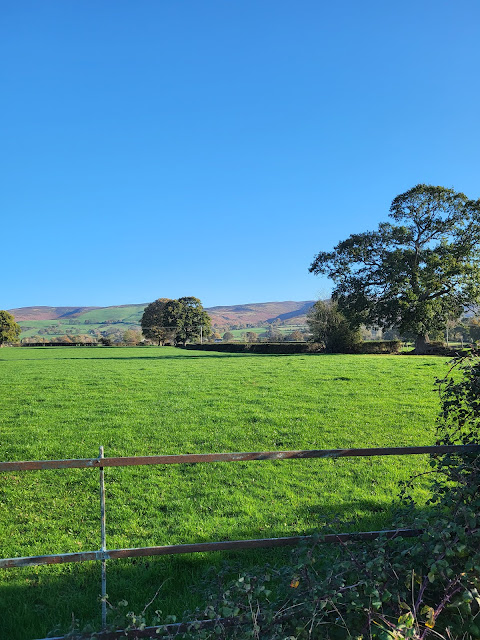The coming of may
May is a time for wildflowers here. The primroses have gone, the wood anenomes are disappearing and the foxgloves have yet to come. But everywhere along verge sides and at the base of the hedgerows wildflowers are crowding out the grass.

The wild cherry blossom and the blackthorn are fading but hawthorn, known also as may for the month of its flowering, is frothing along the hedges. Our hawthorn hedges here on the hill are still resolutely green, but for the sake of a couple of hundred feet (sorry, I know I should think of height in metric terms but it is a painful translation from feet to metres and doesn't mean anything in my head so I will old-fashionedly stick to feet today) the hawthorn trees at by the river in the bottom of the valley are just coming into bloom. Here is the first, the flowers flushed ever so faintly with pink.

Walking today with a heavy pack (practice, practice for the Offa's Dyke, a little easier each time) I saw the impact of height on both plants and animals. Before I reached the river in the bottom and the flowering of the may, I climbed the hill and walked along the ridge to come down the other side of the valley, to walk in what is usually my view. Most of the sheep here lambed weeks ago and the lambs are beginning to round out, still astonishingly prettier than the stolid adult sheep, but no longer utterly beguiling or too pretty to believe, living postcards. But right at the top of the hill there were two tiny ones, perhaps the last for this year. I only caught one, the other was already off, disappearing out of the viewfinder and away across the field.
 As I walked, the verges were full of bluebells and stitchwort. I remember vividly as a child playing in a bluebell wood with my brother, delirious with the blueness of the flowers, rolling in them as if they were water. I tried to pick some to take home for my mother but they drooped even before we got home and I threw them disappointedly in a ditch by the side of the road. I must have been about eight or nine. I don't remember any guilt about the wanton destruction of the flowers. Bluebells were as common as dandelions then, special only because they were so seductively blue and fleeting. Now I know that many of the bluebell woods of my childhood have vanished, grubbed up for agriculture, built upon for housing, but there are still many here in North Wales although now I would not dream of taking anything but photographs.
As I walked, the verges were full of bluebells and stitchwort. I remember vividly as a child playing in a bluebell wood with my brother, delirious with the blueness of the flowers, rolling in them as if they were water. I tried to pick some to take home for my mother but they drooped even before we got home and I threw them disappointedly in a ditch by the side of the road. I must have been about eight or nine. I don't remember any guilt about the wanton destruction of the flowers. Bluebells were as common as dandelions then, special only because they were so seductively blue and fleeting. Now I know that many of the bluebell woods of my childhood have vanished, grubbed up for agriculture, built upon for housing, but there are still many here in North Wales although now I would not dream of taking anything but photographs. 
Stitchwort is a beautiful little flower, easily overlooked but simple and satisfying. It is named for its apparent ability to ease a runner's stitch, a pain in the side. I shall find out the Welsh names for all of these flowers from a Welsh speaking friend. They crowd the hedge bottoms in their thousands.

I am not sure what this one is below, with a lovely clear yellow flower held above leaves not unlike those of a hardy geranium. I think it might be called Tomentil, a form of potentilla, but if anyone knows for sure I would love to know.

The last bit of my walk took me along the River Wheeler, a small river, rushing clear and brown, where otters are often seen, although sadly never yet by me. The banks to either side for yards and yards are white with wild garlic just now, also known as ramsoms. Crush the leaves and flowers and the smell of garlic is pungent.
 It is a beautiful flower, clearly from the same family as the allium in the garden. And thinking of the garden brings on a wry smile. Here I am striving to make a garden in not the easiest of places, reading Beth Chatto about the importance of understanding what plants will happily grow in your soil and trying to create something which will be happy here, sometimes failing, sometimes losing plants to the cold or the stony soil, the picture in my head always years ahead of what you see on the ground. Yet walk the lanes and nature is carelessly throwing out beauty. There is a lesson there again: grow what loves you.
It is a beautiful flower, clearly from the same family as the allium in the garden. And thinking of the garden brings on a wry smile. Here I am striving to make a garden in not the easiest of places, reading Beth Chatto about the importance of understanding what plants will happily grow in your soil and trying to create something which will be happy here, sometimes failing, sometimes losing plants to the cold or the stony soil, the picture in my head always years ahead of what you see on the ground. Yet walk the lanes and nature is carelessly throwing out beauty. There is a lesson there again: grow what loves you.


A beautiful header and a post worthy of attention - I remember picking bluebells as a child and filling the house with them in jam jars - in those days no one thought anything of picking wild flowers! I agree May is a really lovely time of the year! Thank you
ReplyDeleteYou have conjured up a wonderful picture of the amazing lushness of May, I can almost smell the bluebells! There is such promise at this time of year I think. Good luck with your 'training' for Offa's Dyke - I think you are very brave, there was so much up and down on the little bit I walked (about a mile's worth!)
ReplyDeleteElizabeth, your blog is amazing. I am recently retired RN learning to live a simpler life. I have spent a couple of years tracking my husbands Jones line. I suspected Wales but of course needed proof, which I have now. I feel so blessed to have found you. May I follow your blog? Come visit my simple life, blog, in Kentucky.
ReplyDeleteThe yellow flowered plant looks like one in New England which I knew as celandine.
ReplyDeleteLuscious, delicious, gorgeous photos. Spring looks wonderful in your part of the world.
ReplyDeleteI really notice the effect of height on the stage of spring here. We are quite a bit higher than Victoria, where the daffodils, magnolias, camillias have all finished and the dogwood nearly over. Up here we still have daffodils tightly in bud, the magnolia will be another good week and the dogwood buds are still tiny.
What a way you have in showing us the springtime all around you. I am so delighted that you are able to discover the daily arrival of more spring signs.
ReplyDeleteThat little lamb is so beautiful. Just that look at you and your camera is precious.
xo
I was about to say celandine or wood poppy for the yellow flower as well. I'm waiting for my bluebells to bloom, though, when I got them they were called wood hyacinths. They look exactly the same so they probably are. I love to see the baby lambs too. I purposely drive past a farm at least once a week just so I can see the sheep.
ReplyDelete"Grow what loves you." What a wonderful phrase. Or, in your case. "Photograph what loves you." And those photos are wonderful. Thanks you for sharing them.
ReplyDeleteStill too cold on much of the Canadian prairies for many flowers to grow, but we're starting to see signs of life -- like the little lamb you caught.
One item missing -- where's your May Pole, for May Day (or Beltaine). You are in Wales, right?
I know exactly what you mean about the picture in your head and the reality Elizabeth. Sometimes I wonder if the two will every marry up. Beautiful time of year x
ReplyDeleteI loved this walk with you and the photos of the wild flowers. These made up a very interesting post.
ReplyDeleteGreat shots thanks for sharing!
ReplyDeletewhat stunning and evocative descriptios and photos, we have all the same flowers here even the yellow beasty and I know not what tis either! If you find out please let me know!
ReplyDeleteLovely photos - we are so lucky to be able to see all this just by walking out of our front gate and into the surrounding lanes. You describe them all so beautifully too!
ReplyDeletevery lovely young Elizabeth. I'd like to know, too, what happens to half way lambs, we see them easy enough when tiny, then they turn into shagged out old lumps of wool but there must be a teenage phase?
ReplyDeleteThe yellow flower looks like a Crucifer (one of the cabbage famly) to me - there are not only wild ones but some escapees from agriculture. I'm pretty sure it's not Tormentil. Tormentil is very low-growing with tiny yellow flowers, mainly found on heath and among very short grass.
ReplyDeleteThe St Hilary Wood near here is just full of wild garlic and we have some in the garden too. The air is filled with pungence and the leaves are wonderful to chew upon. Thanks for a great wildflower blog. I'll look out for the stitchwort
ReplyDeleteWhat a beautiful and evocative description of a May walk! Your wildflowers seem a little earlier than ours here in North East UK. The bluebells are out - I feasted my eyes on them on Sunday and hope to again tomorrow! And ramsons - Oh bliss!
ReplyDeleteBeautifully observed - such a wonderful and exhilarating time to be in the countryside. I have so looked forward to reading what you see next in your part of Wales.
ReplyDeleteBluebells and Stitchwort - a perfect combination - throw in some Herb Robert and Red Campion too as nature certainly does and sweet little nestling violets...it doesn't get much better does it? Who really needs over-bred and blowsy cultivars after this simple beauty?
I think your yellow flower is Chelidonium majus - Greater Celandine.
I too know it as a Greater Celandine, down here on Anglesey we have are about as far on as your valley walk. Just wish this cold wind would go, its just a bit too cold to sit outside and enjoy the garden.
ReplyDeleteThank you for the identification mountainear and anglesey allsorts (and identifying that my original guess was wrong Scriptor!). Isn't it amazing how much we all used to know about wildflowers and how much of that knowledge has disappeared. I had a conversation with someone the other day who was astonished at the numbers of bright yellow flowers on the verges and did not know that they were dandelions - a generational difference perhaps?
ReplyDeleteI have just realised that morning's minion also offered celandine, thank you.
ReplyDeleteRob, I used to dance round a maypole as a child in England. Here in this part of Wales the tradition is a dance called the Cadi Ha which was being danced in the square in our local village last Saturday. It is local folk dance, a bit like Morris dancing but without the bells and sticks!
Now Beltane is truly ancient, right back to myth. I shall research it.
I love May for its flowers, especially bluebells. At the moment its dandelion time all along the grass verges and alongsides the roads. They really are a cheery yellow. A bit later and it will be Ox-eye daisies. Lovely!
ReplyDeleteHow strange we were both writing about May at the same time! Well not really...it's kind of out there shouting in all its glorious exuberance.
ReplyDeleteReally looking forward to your visit.
Long live May!
I'm glad you're so obviously enjoying your new life. Posts like yours bring rare moments when I miss the Shropshire/Welsh countryside.
ReplyDeleteIf you're looking for a walking challenge next year I can recommend the West Highland Way.
A really lovely post. I think the contrast between the bluebells and stitchwort is fabulous and I am enjoying it every day here. I didn't know about the runners (hill walkers?) pain but I think it looks like ten little long stitches, if you know what I mean!
ReplyDeleteCKx
Like the hellebores on your header, also your wild flower pictures - round here garlic is called Ramsons.
ReplyDeleteInteresting what you say about may blossom. We came back on Tuesday from Heathrow and down there the May is nearly over - the further North we came it got less and less. Here on the farm it is only just in bud (700 feet asl) - but it is always worth waiting for, isn't it>
What a fab entry. My new house has a lot of garden but nothing in the way of actual plants. Starting from scratch is horribly tricky though. The one downside of living at 1200 feet and in the coniferous forest is the absence of the abundance of wild flowers.
ReplyDeleteIncidentally, if you picked just a few of the wild garlic leaves and steam them with monkfish and some slivers of fresh ginger you will have a delicious supper for after your walk!
Hope you can come and see me at my new house soon.
This is sheer blog beauty, Elizabeth....your photographs are gorgeous and so are the descriptions. You have many of the same wild flowers as we do and now I'll look on them with a different eye.
ReplyDeleteLove your new additions to the sidebar too. Have pitched Blackden but so far no luck - will keep trying. Janexxx
i missed this post because i was in ireland. oh it's beautiful!
ReplyDeleteLOvely blog. So good to catch up with your blogs. Grow what you love indeed.
ReplyDeleteIn the winter we planted long rows of edible hedging which is growing well - lots of wild cherry, hawthorn, hazlenut etc.
I adore bluebells. Something magical about them.
xx